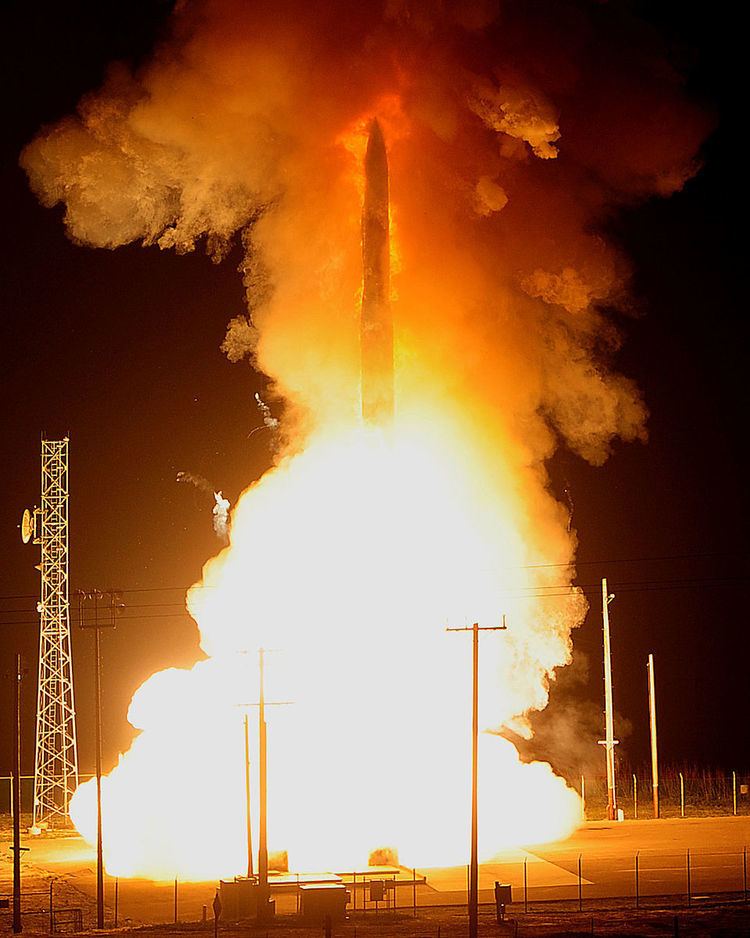Country United States | Type Squadron | |
 | ||
Active 1943-1966; 1991-present Branch United States Air Force Role Intercontinental ballistic missile Garrison/HQ Vandenberg AFB, California | ||
The 576th Flight Test Squadron (576 FLTS) is a United States Air Force direct reporting unit (DRU) assigned to Air Force Global Strike Command (AFGSC). The 576 FLTS is stationed at Vandenberg Air Force Base, California.
Contents
Overview
The mission of the 576 FLTS is to execute Air Force Global Strike Command's Force Development Evaluation program for America's Intercontinental Ballistic Missile Force and serve as the command's experts for missile systems capability and Air Force application demonstrations.
In executing the Intercontinental Ballistic Missile Initial Operational Test and Evaluation and Force Development Evaluation programs, the 576th Flight Test Squadron prepares for and conducts ground and flight tests to collect, analyze, and report performance, accuracy, and reliability data for the Joint Staff, USSTRATCOM, Air Staff, and AFGSC. The 576th Flight Test Squadron identifies missile system requirements, demonstrates current and future war fighting capabilities, and validates missile system improvements and upgrades.
World War II
The 576th Flight Test Squadron was first activated at Davis-Monthan Field, Arizona, on 26 January 1943 as the 576th Bombardment Squadron (Heavy) where it participated in the strategic bombardment campaigns of Europe and Germany as part of Eighth Air Force. Their involvement during the Normandy invasion and the Battle of the Bulge resulted in seven European-African-Middle Eastern Theater campaign streamers and one Distinguished Unit Citation.
The 576th was inactivated on 13 September 1945 with the close of World War II. It was reactivated on 24 September 1947 as a very heavy bombardment squadron at Barksdale Field Louisiana, the squadrons mission was changed in November 1947 to a light jet bomber squadron. It was again inactivated in November 1949.
Intercontinental Ballistic Missile Squadron
The squadron was reactivated on 6 March 1958 as the 576th Strategic Missile Squadron (SMS) assigned to Cooke Air Force Base (later renamed Vandenberg AFB). On 1 April 1958, the 576th was assigned to the Strategic Air Command (SAC) as an SM-65 Atlas ICBM unit, the nation's first ICBM unit.
Initially, the 576th operated launch sites 576 Alpha 1, 2 and 3, which consisted of open support towers with SM-65D Atlas ICBMS standing in the open. The open launch pads remained on nuclear alert until 1 May 1964. In the spring of 1960, began using the "coffin" type shelters and missile erectors at Vandenberg Baker pads 1,2, and 3 along with 576 Charlie, Foxtrot and Golf that were used as a testing pad for the operational testing of the SM-65E Atlas and site 576 D for Atlas F operational testing.
The squadron went off ICBM nuclear alert duties with the inactivation of Alpaha 1,2 and 3, however it continued operational testing of the Atlas ICBM until 1965 when the weapons system was retired and the missiles sent to Norton AFB California for long term storage and use as satellite launch vehicles for NASA.
On 2 April 1966, the 576th was once again inactivated.
ICBM Testing Squadron
Re-designated the 576th Test Squadron on 29 August 1991, it was again activated on 1 September 1991 as part of the activation of the Twentieth Air Force, America's only ICBM numbered Air Force. The 576th designation was chosen to ensure the history and lineage of the 576th would continue with the important job of testing ICBMs. The 576th has almost made a complete circle since the 576th Strategic Missile Squadron tested the Atlas missile in the late 50's and early 60's. In July 1993, the 576th was assigned to the Fourteenth Air Force at Vandenberg AFB. The squadron was re-designated the 576th Flight Test Squadron (FLTS) on 1 July 1994. Then, on 22 February 1996 the squadron was reassigned from the Fourteenth Air Force to Space Warfare Center (SWC) at Schriever AFB, Colorado.
On 14 March 1996, the 576th, the 30th Maintenance Squadron (MXS), and portions of the 30th Logistics Squadron (LSS) merged to form the new 576 FLTS. Whereas the three organizations previously reported, through different commanders, to the 30th Space Wing at Vandenberg AFB, this merger aligned all personnel directly involved with Intercontinental Ballistic Missile (ICBM) testing at Vandenberg under one commander. As part of the merger, the 576 FLTS also became a direct reporting unit to the Space Warfare Center, which later became the Space Innovation & Development Center (SIDC).
On December 1, 2009 the 576 FLTS was reassigned, along with the Air Force's ICBM mission, to Air Force Global Strike Command (AFGSC).
